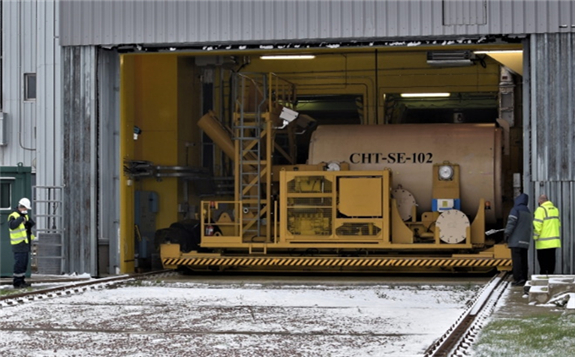The first canister of used nuclear fuel was yesterday loaded into the Interim Spent Nuclear Fuel Storage Facility (ISF-2) at the Chernobyl plant in Ukraine. ISF-2 is the largest dry-type used fuel storage facility in the world and has an operating life of at least 100 years.

More than 21,000 used fuel assemblies accumulated at the Chernobyl site between 1977 and 2000 when its four RBMK reactors were generating electricity. There are currently held in the wet-type ISF-1. This facility is not designed for long-term storage of fuel and its service life is limited, so all used fuel assemblies are to be moved to the newly-built dry-type ISF-2 intermediate storage facility. Each of the fuel assemblies will be disassembled into three parts - two fuel bundles and an activated connecting rod - in a purpose-built 'hot cell', packaged in double-walled transportable canisters and placed into ISF-2.
The first loaded double-walled canister, containing a total of 93 used fuel assemblies from Chernobyl's ageing storage facility, has now been placed in a concrete storage module within ISF-2. The operation was carried out by Chernobyl Nuclear Power Plant (ChNPP) personnel under the supervision of the International Atomic Energy Agency, the State Nuclear Regulatory Inspectorate of Ukraine and Holtec International of the USA.
The principal contractors on the ISF-2 facility project are Ukraine's UTEM, Germany's BNG and Italy's Maloni. The project is supported by the Nuclear Safety Account managed by the London-headquartered European Bank for Reconstruction and Development (EBRD). ISF-2 cost EUR400 million (USD473 million) and was financed with contributions from Belgium, Canada, Denmark, the European Union, Finland, France, Germany, Italy, Japan, the Netherlands, Norway, Russia, Sweden, Switzerland, Ukraine, the UK and the USA.
Holtec took over the project 13 years after Areva had started it in 1998, and began work to develop a fully functional facility using the legacy systems, structures and components supplied by the French engineering company, and acquiring new replacement systems, as needed, from France, Germany, Italy and the USA, among other countries.
The EBRD said the loading of the first used fuel canister into ISF-2 marks the culmination of more than 20 years of work at the site. Balthasar Lindauer, director of the EBRD's Nuclear Safety Department, said: "This is a momentous achievement that stands testament to the many days, weeks and years that the EBRD, donors, contractors and Ukraine have dedicated to delivering this critical safety project. We have had to overcome many challenges to reach this point, but it is all the more gratifying that we eventually got there."
Holtec handed over the ISF-2 complex to the owner, ChNPP, in December 2019. On 7 September this year, ChNPP received a permit to carry out hot testing of the facility. The first batch of nine used fuel assemblies was transported from ISF-1 to ISF-2 on 10 September. Hot tests are scheduled to be completed next month. ChNPP expects to receive a licence to operate SNF-2 in April 2021.
"Important work remains to be completed to secure the full operating licence, expected in early 2021, but the successful testing and loading of the first full fuel load provides all those involved with cause for some celebration," said EBRD Associate Director of Nuclear Safety Steven White.